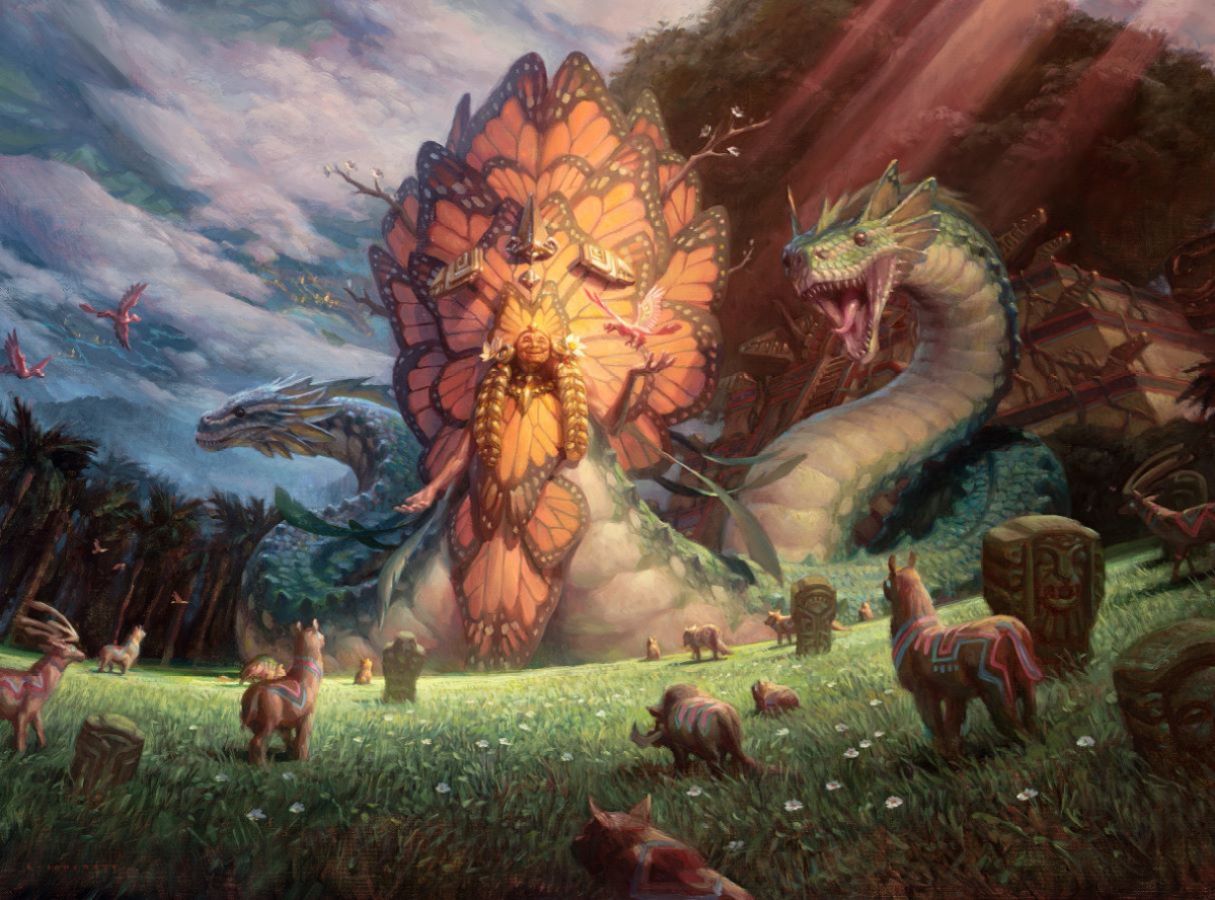Since 2020, Wizards of the Coast has continued reworking its games to make them more inclusive and culturally sensitive. Some fixes, like banning certain Magic: The Gathering cards, were easy and long overdue. However, changing company culture (including hiring practices) and addressing bigotry embedded in the fantasy genre has been a bigger task. With their return to a plane inspired by Indigenous cultures and history for The Lost Caverns of Ixalan, MTG has a prime opportunity to bring the Indigenous community into the conversation.
The first introduction to the plane Ixalan came in 2017 in the set of the same name. MTG crafted an adventurer-themed deck where various characters who seek gold and other treasures on a plane riddled with monsters, ancient ruins, and the sole people left, the Oltec. Modeled after pre-Columbian Mesoamerica and the so-called “Age of Discovery,” Ixalan featured lots of pirates, dinosaurs, vampires, and merfolk. It also featured the then-planeswalker and forever warrior-poet Huatli.
There were some efforts to side-step issues inherently present in theming a deck visually around a genocide. However, ultimately it didn’t work. Eastern Band Cherokee writer Gar Atkins laid this out in detail in his 2017 essay Ixalan through Indigenous Eyes. He talked about how even attempting a lost world idea raises issues, and that reducing colonizers to “evil” vampires doesn’t work. Atkins and others explained that the art cues and foundational text with a lack of Indigenous consults made this attempt a miss. How much of a miss depends on who you ask.
Diving back into Ixalan
As WOTC decided to re-enter the world, some changes were made in alignment with the 2020 statements. So, not every element of the original concept is returning. This summer, Mark Rosewater, Head Designer at MTG, shared on Twitter that MTG began using “typal” instead of “tribal” internally. This change came after concerns from cultural consults. This wording was introduced in the original Ixalan, but is generally being phased out of the game. Additionally, the team working on this set is much more diverse, from the artist pool to the art directors. Art Directors Ovidio Cartagena and Deborah García bring their connected experiences of Latin America with them. These are not fixes, but resources that would help any set.
The Lost Caverns of Ixalan may lean into the hollow Earth tropes of speculative fiction but still keep the exploration of a place removed from the present as a foundation. This means that the cultures of Ixalan still reflect the history of and leading up to the colonization of Latin America. For example, Don Andres and Clavileño are two of many Spanish conquistador-looking creatures. Additionally, resource extraction remains tied to the story. Resource extraction via capitalism is an ongoing issue for Indigenous people and their sovereignty today.
Lost potential

With these connections, and WOTC releasing the deck during Native American History Month, it feels like a missed opportunity to not do more front-facing promotional fare with the real people Ixalan pulls from. I mean Indigenous people of the Americas, but more specifically the Indigenous communities of Central America and the Southwest U.S. WOTC could raise money for an Indigenous charity struggling with ongoing colonization. They could work with Indigenous influencers and creatives. It’s not like they aren’t already interacting with the game. Two years ago, Dakota Sioux writer and MTG enthusiast Obadiah Eastman shared a deck created around the Lakota figure Unk Cekula using pre-existing cards. Any (willing) Indigenous creatives who work on this set should get featured for interviews or spotlights.
From what’s available online, the creatives who worked on this set (and most sets) span four continents. While many are Latine, none identified as Indigenous. Just because someone has mixed racial heritage (particularly mestizo), as many do in Latin America, doesn’t mean they identify as Indigenous. In some ways, race is interpreted differently in countries colonized by Spain and Portugal. However, in many ways, it’s the same i.e. very anti-Indigenous and anti-Black. That, among many other contemporary and historical reasons, is why including Indigenous voices matters.
Between previewing the cards and reading Cartagena’s (who grew up in Guatemala) interview with Polygon, it’s obvious that a lot of care went into revisiting Ixalan. However, it doesn’t appear to confront the unshakeable baggage rooted in Ixalan as a concept. Bringing in people in the present doesn’t change the foundation unless they completely rework it. It does give back to the communities WOTC profits from and shares its stories directly with the players. Not as people of the past, but of the present and future. All the ideas and more could really be done at any time. WOTC does not and should not wait to include Indigenous people for NAHM or a set like Ixalan. Now is a great time to start.
(featured image: Anna Podedworna/Wizards of the Coast)










Published: Nov 4, 2023 04:09 pm